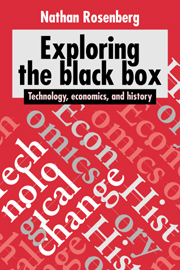Book contents
- Frontmatter
- Contents
- List of figures
- Preface
- Introduction
- Part I Dealing with an uncertain future
- Part II Technology in context
- Part III Sectoral studies in technological change
- 9 Energy-efficient technologies: past and future perspectives
- 10 Innovation in the chemical processing industries
- 11 Telecommunications: complex, uncertain, and path dependent
- 12 Understanding the adoption of new technology in the forest products industry
- 13 Scientific instrumentation and university research
- Index
13 - Scientific instrumentation and university research
Published online by Cambridge University Press: 12 November 2009
- Frontmatter
- Contents
- List of figures
- Preface
- Introduction
- Part I Dealing with an uncertain future
- Part II Technology in context
- Part III Sectoral studies in technological change
- 9 Energy-efficient technologies: past and future perspectives
- 10 Innovation in the chemical processing industries
- 11 Telecommunications: complex, uncertain, and path dependent
- 12 Understanding the adoption of new technology in the forest products industry
- 13 Scientific instrumentation and university research
- Index
Summary
Introduction
The purpose of this chapter is to examine certain roles played by American research universities in the development of an important category of technology: scientific instruments. In the years since the Second World War the research universities performed much more complex functions than can be summarized in the statement that they served as the main centers for the performance of basic research, although that is obviously fundamental. In addition, within the university context, and in connection with the performance of basic research, there took place a complex interplay between scientific and technological forces that led to other potentially significant outcomes. Obviously, the immediate increments to knowledge resulting from basic research itself are, sometimes, of the greatest economic significance. However, I will suggest that there have been paths of influence and causation that have not yet been systematically identified or examined, much less measured. I will further suggest that the emergence and diffusion of new technologies of instrumentation (as well as new research methodologies) are central and neglected consequences of university basic research. As a result, the eventual economic impact of basic research, taking place in a particular academic discipline, has commonly expressed itself through the medium of new instrumentation technologies and the subsequent life histories of these new technologies. This chapter attempts to provide some preliminary mapping of such lines of influence.
What follows, then, is obviously exploratory and not definitive. Nevertheless, if its central conclusion is correct, this chapter points to the importance of a more thorough examination of the role played by university research as the source of a highly influential category of modern technology: instruments of observation and measurement.
- Type
- Chapter
- Information
- Exploring the Black BoxTechnology, Economics, and History, pp. 250 - 263Publisher: Cambridge University PressPrint publication year: 1994
- 1
- Cited by



